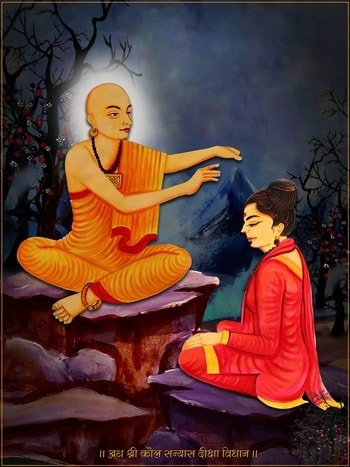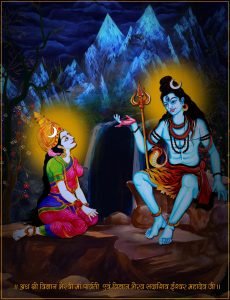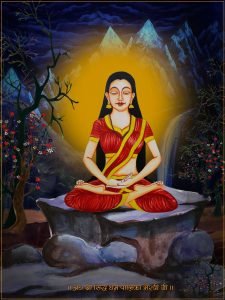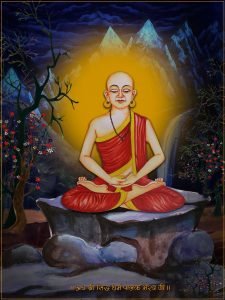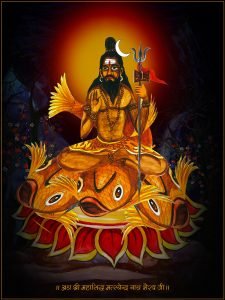The “Siddha Kaula Sannyasa” is a unique sannyasa system different from the traditional concept of sannyasa of Hinduism, Bhikshu of Jain and Buddhist doctrine. This doctrine is solely based on the concept of sannyasa as propounded by His Holiness Kaulantak Peethadhishwara Mahasiddha Ishaputra and the traditional guru-disciple tradition of the Siddhas. This system is not based upon one renunciation and vanaprastha alone but there are various things to be taken into consideration when it comes to the sannyasa.
Furthermore, the Siddha Kaula Sannyasa has its philosophy. Its philosophy is explained through the three-tier system of sannyasa. This form of Sannyasa is a unique form of sannyasa which was only practiced in the Himalayas and under guru-disciple tradition. Since the system was propounded in the society by His Holiness Mahasiddha Ishaputra, there is no literature available, therefore, the final authority about the Siddha Kaula Sannyasa rests upon him.
Etymology
As per the “Kaula Siddha” dharma, sannyasa name was derived from sannyasa. The original word is sannyasa (sama+nyasa), where sama means samanata (equality), samarpana (total surrender) and samyama (patience), sama (secular and not to be confused with political secular) whereas “Nyasa” means a tantric term used for the establishment of vital energies and virtues inside the human body. Therefore, the synthesis of those words gives the meaning that “Sannyasa” means to imbibe or to establish virtues like equality, surrender, patience inside oneself so that the person becomes secular.
The person who embraces sannyasa in the core becomes a secular person because the person harbors no attachments to any forms of the social system, social hierarchy, caste system, varna vyavastha, the notion of high and low class. They are in their core, a secular being who does not follow any forms of varna vyavastha. Since they are secular, they walk in the path to severe all forms of attachments of the world except with guru and his traditions because as per “Kaula Siddha” dharma, the sanyasi cannot cut off ties with the guru and expect spiritual development in future. Furthermore, the role of the guru is paramount in Kaula Siddha dharma.
Eligibility for Kaula Siddha Sannyasa
As per “Kaula Siddha” dharma, any person willing to take the sannyasa Deeksha have to prove their eligibility. A person is only considered eligible for the sannyasa as per “Kaula Siddha” dharma after having spent one to two years in the peeth and also has taken more than twenty deeksha or if His Holiness thinks appropriate for him to initiate someone into sannyasa. The ultimate authority lies in His Holiness when it comes to the Sannyasa Deeksha.
The second criterion for the sannyasa Deeksha is that the person should have a strong purpose behind taking the Deeksha. The purpose like renunciation for the sake of title, name, and fame is not entertained and will never be entertained. The main purpose of any person for the sannyasa deeksha should be to attain the state of “Siddhatva” or “Siddhahood”. The definition of “Siddhatwa” means to achieve the Siddha state. The Siddha state requires the person to severe ties with the family members, relatives, and demands complete surrender to guru and the tradition. The person in a way consents to surrender all desires and yearnings and to imbibe in them the sewa bhava “devotional attitude”.
As per “Kaula Siddha” dharma, sannyasa also means a consent given by a person to render their sewa or devotional service to the guru and with no consideration whatsoever. It is purely for sewa with expecting nothing in return. The person who wants to receive deeksha has to personally request the guru for the deeksha. Only when the guru deems that the person who makes the request is fit for Deeksha, the guru shall then initiate the person.
Lastly, as per “Siddha Dharma”, the person who is willing to take the sannyasa deeksha should have a strong allegiance to the guru-disciple tradition. Furthermore, the person should have a deep reverence for various wisdom forms especially Tantra, Mantra, Yoga, Ayurveda, etc. The person should also have a deep reverence for Kaulantak Peeth, the person should also know various facets of Kaulantak Peeth, the head of Kaulantak Peeth i.e. Kaulantak Nath or Kaulantak Peethadhishwara. The person should also know the rules and regulations of the Kaulantak Peeth and should have also adhered to the rules and regulations. Last but not the least, the person who wants to undertake the Sannyasa Deeksha should be recognized Bhairava/Bhairavi by Kaulantak Nath and not as a sobriquet or anointment. Not all persons who take deeksha from the Peeth and who are called Bhairava/Bhairavi do not automatically qualify for the sannyasa deeksha.
History of Kaula Siddha Sanyasa
As per “Kaula Siddha”, when Lord Shiva manifested in Kailasha and he assumed a human form and established himself as Kaulantak Peethadhishwara, the gods and goddesses of this world along with Nath and Siddhas rushed to the Kailasha to have his divine glimpse. In the process, they all quit their family, wives, children, society, and everything. They then started settling in Kailasha. Even bhoot, pret, pisach, kinnar, etc went to the Kailash abandoning everything. They all settled in Kailasha and they were known as “Aughad”.
The Aughad are not bound by any rules whatsoever. They remain free from all forms of expectations and standards prescribed by society. The Aughad lineage continued until the time when Lord Shiva was not married to Ma Parvati. Ma Parvati then changed the rules for Aughads. Because of some rule changes and systematization of the Aughad lineage, it then became divided into three parts. The first is Aughad itself, the second is Nath and Siddha and the third is Avadhoota.
As per “Siddha Dharma”, the Aughad was disarranged and not a systematic lineage. The Aughads were free to do anything they like but with Nath and Siddhas, it was not the same. The Nath and Siddhas, they had their kula, systems, and standards to maintain and follow. The last and highest stage was that of Avadhota.
The Avadhutas were a supremely free person. They were as similar to Aughads but Aughads were tamasic in nature while Avadhutas were beyond the three gunas. Avadhuta were free from everything and they were highly adept beings on the other hand Aughad were the starting phases.
When Ma Parvati divided the Aughad lineage into Aughad, Nath, and Siddhas, Avadhuta, the rules, and standards prescribed by her became known as sannyasa. The sannyasa system of the Aughad and other lineages were different from the modern-day sannyasa system. The modern-day system as already mentioned is more like entering into the jungle.
Who can bestow Kaula Sanyasa Deeksha?
As per “Kaula Siddha Dharma”, the following people can bestow sannyasa to people and aspirants.
- Kaulantak Peethadhishwar
- Kaulantak Peethadhishwari*
- Head of nyaya mandala*
- Mahatpati*
The Kaulantak Peethadhishwara can impart sannyasa based on his discretion and he is bounded by nothing except traditional rules prescribed by Gurumandala while the other people can only bestow sannyasa in special conditions. The Kaulantak Peethadhishwari can only impart Sannyasa Deeksha if she has taken the Deeksha herself and performed it herself. Similar is with the head of nyaya mandala and Mahatpati. They can only impart sannyasa, if they have been initiated into sannyasa and if they have completed their sannyasa vows and resolutions
Can sannyasa be imparted by Sapatni Peethadhishwara?
As per “Siddha Dharma”, sannyasa could never be imparted by Sapatni Peethadhishwara until the point of Mahasiddha Matsyendra Nath Ji Maharaja. The Peethadhishwara before him married and when they became Peethadhishwara, they forfeited their wives, children and then assumed the duty of Kaulantak Peethadhishwara. Mahasiddha Matsyendra Nath Ji married while he was still Peethadhishwara. A big controversy then erupted because of Mahasiddha Matsyendra Nath Ji’s marriage which had to be solved as he was Grihastha and he was imparting sannyasa to others. Most of his disciples were Brahmachari while he was a Grihastha and the question that was put forward was, “If Grihasta can impart samhara sannyasa to brahmacharis?”. This question had to be referred to Gurumandala and Nyaya Mandala.
As per “Kaula Siddha” dharma, after much speculation from the Gurumandala and Nyaya Mandala, they reached a consensus that Mahasiddha Matsyendra Nath Ji could still retain his seat of Peethadhishwara because he was an unprecedented Mahasiddha in the history of tantra. His works on reviving lost spiritual wisdom outweighed his marital life. They then gave full authority to Mahasiddha Matsyendra Nath Ji because they also opined that Lord Shiva, the first Peethadhiswara was also married and Ma Parvati is considered to be eternal Peethadhishwari.
After Mahasiddha Matsyendra Nath Ji was given permission, he then proclaimed and stated that in the future, if a Peethadhishwara wishes to marry, they have the full right to marry and perform the works of dharma. He also made the rule that the Grihasta Peethadhishwara can impart sannyasa to sadhaka and this shall be applicable for all future Kaulantak Peethadhishwara because he also opined that when a Siddha reaches the state of Mahayoga or becomes Mahayogi, the attained state never perishes. The person becomes a nitya yogi or a permanent yogi.
General Protocols for Sannyasi/Sannyasini
As per “Kaula Siddha Dharma”, after embracing sannyasa, sadhakas are bound by their rules and regulations. They have moral standards to follow. The rules and regulations are explained in brief in the respective sannyasa section of this page. Some rules and regulations are as follows.
Shringara
Shringara or adornment is one of the main protocols of the Sannyasi and it has to follow compulsorily because the adornment style determines the sannyasa. There are two important forms of shringara. They are,
Shringar rahit
This form of adornment means to adorn oneself naturally and not overtly beautifying oneself. For instance, for Bhairava Sannyasi, the shringara rahit would mean to not use a comb on the hair or to use a blade to their mustache and beards. For Bhairavi, it would mean to not wear adornments like excessive jewelry, props and to stay as much away from Guru as possible. To maintain proximity with Guru is the most fundamental aspect of “Shringar Rahit” and it is based on the principle of “vairaga” or dispassion.
Shringar sahit
This form of adornment means to adorn oneself in the way they deem good for them but within the bounds of sanyasa. The Bhairava/Bhairavi sannyasi can adorn themself their way but it has to ultimately reflect the tradition they are in. For instance, both Bhairava/Bhairavi aren’t allowed to wear jeans because jeans don’t radiate any aspects of Kaula Siddha tradition. The proximity of Guru is not important because they stay near to Guru for the sake of learning various kala (art forms). Art forms imply passion.
Uchha Asana (Elevated Seat)
The sannyasi does not sit in the level with other Bhairava/Bhairavis. Their seat is little elevated compared to other Bhairava/Bhairavis which also implies seniority. They are given more priority in spiritual stuff than other regular Bhairava/Bhairavis.
Food Etiquette
They have a food etiquette to follow and its a very strict etiquette. They cannot utter the words cat, dogs, and other animals while eating except for cow. If they do so they have to abandon their meal. They can cook for other Bhairava/Bhairavis but cannot serve them because of seniority. Furthermore, sannyasi is barred from serving any Grihastis.
Miscellaneous
Some of the rules and regulations for the sannyasis that are equally important are the bathing ritual. The sannyasis have to bath in special events and festivals early in the morning as a sign of dedication to Kaula Siddha tradition. Furthermore, covering their head is the most important virtue for going in front of Guru, deities, and also at the time of eating any meal.
As per “Kaula Siddha Dharma”, covering the head means the sign of respect. Open head means a person not following any forms of rules and regulations. The sannyasa system doesn’t prefer its sannyasi not adhering to its rules and regulations, therefore, covering the head area also implies utmost dedication to the sannyasa system.
Three systems of Sannyasa
As per “Kaula Siddha” dharma, there are three systems of Sannyasa. The three systems of sannyasa are based upon the three motions of the universe. The universe when creates itself it becomes “Sristi Krama” when the universe sustains and maintains its creation, it becomes “Sthiti Krama” and when the universe moves towards its dissolution, it becomes “Samhara Krama”.
Similarly, the person willing to take sannyasa should also know which system of sannyasa they wish to undertake. For instance, if the person is inclined to worldliness and yet they want to maintain spiritual life or vice versa, “sristi krama” is more suited for the person. If the person wishes to quit everything and be fully dedicated to the tradition of “Kaula Siddha” lineage, the person then will be more suited for samhara krama. Sthiti Krama is the middle path between sanghara krama and sristi krama. If a person wishes to samhara deeksha for a limited amount of time then it is “sthiti krama”.
Siddha Shristi Krama
As per “Kaula Siddha” dharma, there are altogether four types of “Siddha Shristi Krama”. They are,
Kaala Yukta Shristi Sannyasa
This form of sannyasa is taken for completion of certain types of sadhana which requires some form of sannyasa deeksha as a prerequisite. The minimum time for this sannyasa is twenty-one days and the maximum period is six months. In the sannyasa period, the person should strictly follow Brahmacharya and the person cannot have any contacts with blood relations, relatives, family members, friends, and any person who you know from before. The sannyasa dress code i.e. Kaulchari dress code should be followed strictly. When the period of the sannyasa concludes, the sannyasa also concludes.
Sristi Ratri Sannyasa
This form of sannyasa is taken for a specific purpose of carrying out sadhana in the night time therefore, the person will remain awake at night time, perform sadhanas, and would go to sleep after sunrise and would have to wake up before sunset. The minimum period for the deeksha is three months to a maximum of one year. The dress code for sannyasa applies all the time. Celibacy should be followed strictly. The person is not allowed to communicate with near and dear ones including relatives, blood relations, etc like the previous sannyasa deeksha.
Sristi Rati Sannyasa
As per “Siddha Dharma”, this form of sannyasa is particularly favorable for householders because this sannyasa system doesn’t demand absolute celibacy. The person can be with his spouse and yet become a sanyasi. Besides one’s spouse, a person is barred from meeting any other person like relatives, blood relations except son and daughter. One should also keep away from public gatherings. The dress code is only required only at the time of performing sadhana. The main aim of this sannyasa is to practice sadhana while being household and performing duties. One should always refrain from overindulgence and sense pleasures like entertainment etc. One should also refrain from being extremist in the case of indulgence that defeats the purpose of Brahmacharya. One should eat raw food and if not then swapaki (self-made) food for penance.
Mahashristi Sannyasa
As per “Siddha Dharma”, this form of sannyasa is minimum for a year and maximum for nine years It is a little relaxed form of sannyasa because the person if wishes may or may not live with their spouse if they want to be engaged in social activities, they are free to do so but inside their private premises like house and property, the dress code applies compulsorily. The dress code is relaxed when the person leaves the property premises. Wherever the person lives, they have to establish the sannyasa tantra and kima beeja in the wall or kam beeja yantra. The person has to feed on khappar patra or skull cup. They should also carry small trishula as representation, damaru, bell, and vajra compulsorily.
Sthiti Sannyasa
As per “Siddha Dharma”, there are three types of “Sthiti Sannyasa”. They are,
Gurusevas Sthiti Sanyasi
As per “Siddha Dharma”, the period of the course is a minimum of six months to a maximum of five years. Sthiti sannyasa means renunciation of everything for the allotted time. If the person with the sannyasa deeksha lives in the ashram or the proximity of Kaulantak Nath, the dress code applies and the person should also wear rudraksh mala. When the person leaves the ashram for personal purpose like shopping, formalities, duties the dress code doesn’t apply. The main purpose of this sannyasa is “Guruseva”.
Peethsewa Sthiti Sannyasa
As per “Kaula Siddha” dharma, there are no periods or limits for this sannyasa. No distinction is made between married and unmarried persons. Both are eligible for the deeksha. There are no restrictions or terms and conditions for marriage. The person can adhere to the traditions, rules, and regulations through their understanding. The person cannot possess private property outside the peeth unless Kaulantak Nath consents. The dress code is compulsory for all when they live in the ashram premises, once they leave the ashram and go out for a particular person, the sannyasa would be annihilated.
Purna Sthiti Sannyasa
As per “Kaulan Siddha” dharma, the sannyasa is for life long. A person cannot marry but has to dedicate their lives to the guru and the tradition. The person has to wear a Kaula Sannyasa dress every time. The person should also adhere to the philosophies of Siddha and embrace the lifestyle as propounded by the Siddhas. Celibacy is very important in this sannyasa
Samhara Sannyasa
As per “Siddha Dharma”, there are two types of Samhara deeksha and both are life-long deeksha. The last rites of the person are also performed in lien of the Kaulantak Peeth rules and regulations. The person then takes this form of sannyasa, the last rites or the death rite being performed through Kaulantak Peeth tradition will be implied automatically. The dress code was very strict in the guru-disciple tradition until the year 2004. The gurumandala then eased the dress code because of the advent of Kali yuga. They opined that in Kali yuga, ascetics, hermits, and sages won’t be respected anymore therefore, easing the dress code was done to safeguard the sages from people. For instance, the Palghar mob lynching happened because they were identified as sadhus by their clothes
Aashraya Samhara Sannyasa
As per “Siddha Dharma”, this sadhana is about renunciation and cutting all ties with one’s family members. They fully embrace the Siddha lifestyle. The word “Ashraya” is used because the person will be living in the guru’s tutelage. There are some norms and standards that have to be followed strictly except on some special occasions, festivals, and outside the premises of the ashram. The dress code doesn’t apply when the sanyasi undertakes a journey somewhere for their safeguard.
Furthermore, the sanyasi should have a bhojan patra, asana, vajra, gurumurti compulsorily. The dress code that normally isn’t applicable while being in the public domain is only applicable to the extent that the sanyasi is not carrying out spiritual activities related to Siddhi Kaula dharma, Mahasiddha Ishaputra, Kaulantak Nath and Kaulantak Peeth.
Mukt Samyasa (vanaprasthi):
As per “Kaula Siddha Dharma”, the sanyasi after having spent 5 years in gurus tutelage where the sanyasi had performed sadhanas, been initiated into various deeksha, yoga, tantra, well versed in “Siddha Darshana”, the sanyasis can then request the release so that they could move to the forest, Himalaya or secluded place, build an ashram and perform sadhana there. The sanyasi has to eat from the khappar patra. A small trishula should also be kept as representation along with damaru, ghanti, vajra and khatvanga. The dress code applies to the person in the Himalaya too.
A sanyasi undertaking this form of sanyasi is a pure Kaula Siddha sanyasi who is free from all the bondages of the society and walks in the path of perfection of sadhana being free while the person is still alive.
DIFFERENCE WITH OTHER SANAYAS SYSTEM
As per “Kaula Siddha” dharma, its sannyasa system is comparatively different philosophically as well as pragmatically compared to other forms of sannyasa. Other forms of sannyasa are based on “Char Purusarth” or four stages of human pursuit but the sannyasa of “Kaula Siddha” dharma is based on Shree Vidhya because Kaulantak Peeth is a rajasic peeth. The sannyasa system is purely tantric is based upon different forms of Shree Vidhya and is purely based on Maya.
The Kaula Siddhas are purely Mayavadis meaning they do not perceive Maya as an illusion but a reality. The Siddhas view Maya and Brahma are the same. Since there is no difference between Shiva and Shakti, Maya and Brahma therefore, excluding Maya from the sadhana doesn’t lead to spiritual development. The path of Brahma or the path of Shiva is always from the path of Maya and Shakti. To deny Shakti is to deny Shiva. This is the core sannyasa principle of the “Kaula Siddha” sannyasa.
Since the Kaula Siddhas do not differentiate between Shiva and Shakti, therefore they do not forgo society and once. The Kaula Siddha sannyasa also doesn’t prescribe vanaprastha or forest-dwelling all at once. It is the final stage. The persons who undertake sannyasa mostly stay in society and carry out their duty.
Unlike other sannyasa, the Kaula Siddha dharma’s essence is the society because the Siddhas after taking the samhara sannyasa goes to secluded places, performs research, and sadhanas. They perfect their sadhanas and they find new wisdom and they use that wisdom for the betterment of the society. Society is the end of Siddha’s wisdom as Siddha’s wisdom is mainly for betterment of the society
The Dress Code
Kaula Siddha’s dress code is one of the most important facts of sannyasa. The dress code is prescribed mainly to bind the sanyasi to the vows taken at the time of sannyasa because a cloth psychologically curves human behavior. Dhoti has no pocket. Red Dhoti with the yellow border or loincloth is the dress code of Kaula Siddha sannyasis. The dress of Kaula Siddha sanyasis has no pocket therefore not much attachment to the world even though they embrace Maya. There are two main dress code and other additional codes,
-Kaulachari vastra
– Himalayan dress
– Sanyasi can wear royal dresses in times of festivals and spiritual events.
The Methods of Kaula Siddha sannyasa
The method of Kaula Siddha sannyasa is purely tantric or it follows the tantric method of sannyasa. Sannyasa is bestowed after performing various rituals and sanskaras. The deeksha ends with shaakti deeksha and an oath is then taken from the sanyasis and a name is then bestowed to the sanyasi. Following are the list of sanskaras,
-Yantra mandala upasana
-Karmakand
-Devi devata, Chaurasi siddha ka homa and yagya
-Bhasma sanskar
-Suddhi sanskar
-Snana sanskar
-Tapana sanskar
-Namdana sanskara
-Mantra sanskara
-Shakti Deeksha Sanskara/Deeksha

